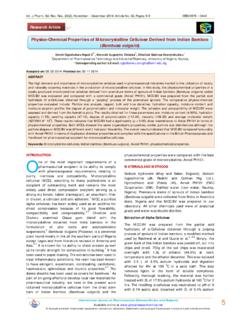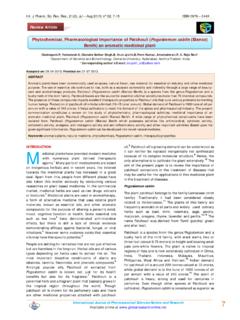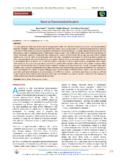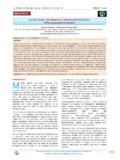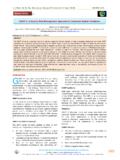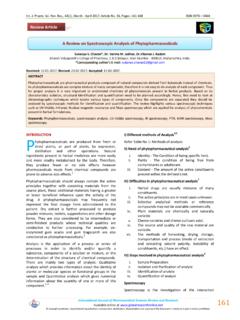Transcription of BUCCAL PATCH: A TECHNICAL NOTE - Global Research Online
1 Volume 4, Issue 3, September October 2010; Article 029 ISSN 0976 044X International Journal of Pharmaceutical Sciences Review and Research Page 178 Available Online at BUCCAL patch : A TECHNICAL NOTE Harshad G. Parmar*, Janak J. Jain, Tarun K. Patel, Vishnu M. Patel College of Pharmaceutical Education and Research , Motipura, Himatnagar-383001, Gujarat, India *Email: ABSTRACT Rapid developments in the field of molecular biology and gene technology resulted in generation of many macromolecular drugs including peptides, proteins, polysaccharides and nucleic acids in great number possessing superior pharmacological efficacy with site specificity and devoid of untoward and toxic effects. However, the main impediment for the oral delivery of these drugs as potential therapeutic agents is their extensive presystemic metabolism, instability in acidic environment resulting into inadequate and erratic oral absorption.
2 Parentral route of administration is the only established route that overcomes all these drawbacks associated with these orally less/inefficient drugs. But, these formulations are costly, have least patient compliance, require repeated administration, in addition to the other hazardous effects associated with this route. Direct access to the systemic circulation through the internal jugular vein bypasses drugs from the hepatic first pass metabolism leading to high bioavailability. This paper aims to review the developments in the BUCCAL adhesive drug delivery systems to provide basic principles to the young scientists, which will be useful to circumvent the difficulties associated with the formulation design. Keywords: BUCCAL mucosa, Permeation, Transmucosal, Drug delivery. INTRODUCTION The mucosa is considered as potential sites for drug administration. Transmucosal routes of drug delivery ( , the mucosal linings of the nasal, rectal, vagina, ocular and oral cavity) offer distinct advantages over peroral administration for systemic drug delivery1.
3 These advantages includes possible bypass of the first pass effect, avoidance of presystemic elimination of gastro intestinal tract and depending on the particular drug. A better enzymatic flora for drug ,3 Components or structural features of oral cavity: Oral cavity is that area of mouth delineated by the lips, cheeks, hard palate, soft palate and floor of mouth. The oral cavity consists of two regions4. Outer oral vestibule, which is bounded by cheeks, lips, teeth and gingival (gums). Oral cavity proper, which extends from teeth and gums back to the fauces (which lead to pharynx) with the roof comprising the hard and soft palate. The tongue projects from the floor of the cavity. Figure 1: Structure of oral cavity BUCCAL PATCHES BUCCAL patch is a nondissolving thin matrix modified-release dosage form composed of one or more polymer films or layers containing the drug and/or other excipients.
4 The patch may contain a mucoadhesive polymer layer which bonds to the oral mucosa, gingiva, or teeth for controlled release of the drug into the oral mucosa (unidirectional release), oral cavity (unidirectional release), or both (bidirectional release). The patch is removed from the mouth and disposed of after a specified time5,6. TYPES 1. Matrix type (Bi-directional): The BUCCAL patch designed in a matrix configuration contains drug, adhesive, and additives mixed together. Bi-directional (Figure 1) patches release drug in both the mucosa and the mouth Figure 2: BUCCAL patch designed for Bidirectional drug release 2. Reservoir type (Unidirectional): The BUCCAL patch designed in a reservoir system contains a cavity for the drug and additives separate from the adhesive. An impermeable backing is applied to control the direction of drug delivery; to reduce patch deformation and disintegration while in the mouth; and to prevent drug loss7.
5 Figure 3: BUCCAL patch designed for Unidirectional drug release Volume 4, Issue 3, September October 2010; Article 029 ISSN 0976 044X International Journal of Pharmaceutical Sciences Review and Research Page 179 Available Online at COMPOSITION Active ingredient Polymer (adhesive layer): hydroxyethylcellulose, hydroxypropylcellulose, poly (vinylpyrrolidone) and poly(vinylalcohol). (Carbopol 934 and PVP). And other mucoadhesive polymer8. Diluents: Lactose CD selected as diluent for its high aqueous solubility, its flavoring characteristics, and its physical mechanical properties, which make it suitable for direct compression. MCS, Starch, DCP, etc. Sweetening agent; Sucralose, Aspartame, Mannitol, etc Flavoring agent: Menthol, Vanillin, Clove Oil, etc.
6 Backing layer: Ethyl Cellulose, etc Penetration enhancer: Plasticizer: ,400, Propylene Glycol, etc IMPORTANT CONSIDERATION In these cases, the adhesive polymer serves either as a drug carrier itself, or an adhesive layer link between a drug-loaded layer and the mucosa, or a shield to cover a drug-containing disc. The design of these patches provides either unidirectional or bidirectional release of the drug. The size of such systems typically varies from 1 to 16 cm, depending on the specific purpose of the application. Usually, 1 to 3 cm, patches is commonly used because of convenience and comfort9,10,11. However, the administration site is also a factor. Large-size patches can be administered at the central position of the BUCCAL mucosa, ( , center of the cheek), whereas the sublingual and gingival sites require a rather small-sized patch12. A variety of polymers can be used for oral mucosal patches.
7 This includes water soluble and insoluble polymers of both ionic and nonionic types. With soluble polymer systems, drug release is accompanied by dissolution of the polymer; therefore the overall drug release rate and duration are determined by both polymer dissolution and drug diffusion, whereas in a nonsoluble hydro gel system, drug release follows fickian or nonfickian diffusion kinetics, depending on design13,14. A preferred mucoadhesive and elastomer are polyacrylic acid (PAA) and polyisobutylene (PIB), respectively15. The duration of mucosal adhesion of different bioadhesive patches varies from minutes to days depending on the type of polymer used, its amount per patch , and additional factors such as the drying technique used to prepare the patches16. METHOD OF PREPARATION Two methods used to prepare adhesive patches include Solvent casting In this, all patch excipients including the drug co-dispersed in an organic solvent and coated onto a sheet of release liner.
8 After solvent evaporation, a thin layer of the protective backing material is laminated onto the sheet of coated release liner to form a laminate that is die-cut to form patches of the desired size and geometry17. Direct milling In this, patches are manufactured without the use of solvents (solvent-free). Drug and excipients are mechanically mixed by direct milling or by kneading, usually without the presence of any liquids18. After the mixing process, the resultant material is rolled on a release liner until the desired thickness is achieved. The backing material is then laminated as previously described19. While there are only minor or even no differences in patch performance between patches fabricated with the two processes, the solvent-free process is preferred because there is no possibility of residual solvents and no associated solvent-related health issues20.
9 EVALUATION Physical evaluation It includes- Weight uniformity, Content uniformity, Thickness- uniformity, ass uniformity. Mass uniformity tested in different randomly selected patches from each batch and patch thickness measured at 5 different randomly selected spots using a screw gauge21. Surface pH The surface pH of the BUCCAL tablets was determined in order to investigate the possibility of any side effects in vivo. As an acidic or alkaline pH may cause irritation to the BUCCAL mucosa, it was determined to keep the surface pH as close to neutral as possible22. The method adopted by Bottenberg et al was used to determine the surface pH of the tablet. A combined glass electrode was used for this purpose. The tablet was allowed to swell by keeping it in contact with 1 mL of distilled water (pH ) for 2 hours at room temperature. The pH was measured by bringing the electrode in contact with the surface of the tablet and allowing it to equilibrate for 1 minute.
10 Swelling index: BUCCAL patches were weighed individually (W1) and placed separately in 2% agar gel plates with the core facing the gel surface and incubated at 370C 10C. At regular 1- hour time intervals until 6 hours, the tablet was removed from the Petri dish, and excess surface water was removed carefully with filter paper. The swollen Volume 4, Issue 3, September October 2010; Article 029 ISSN 0976 044X International Journal of Pharmaceutical Sciences Review and Research Page 180 Available Online at tablet was then reweighed (W2) and the swelling index (SI) was calculated using the formula given in equation. Swelling Index = (W2-W1) X 100 W1 Ex vivo mucoadhesive strength A modified balance method used for determining the ex vivo mucoadhesive strength as shown in figure 3.

